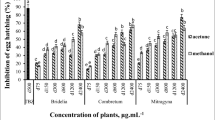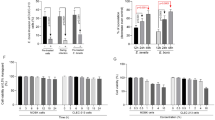Abstract
A total of 43 plant substances provided as raw material and different kinds of extracts (aqueous, ethanol, and heptane) from 18 different organic wastes obtained from the food/feed industry were investigated for their in vitro activities against clonal cultures of Histomonas meleagridis, Tetratrichomonas gallinarum, and Blastocystis sp. Ethanolic extracts of thyme, saw palmetto, grape seed, and pumpkin fruit proved to be most efficacious. Thus, these extracts were further tested in vivo in turkeys experimentally infected with H. meleagridis by administrating the substances to the birds through the drinking water. Even though a delayed mortality was noticed in some birds medicated with the extracts of thyme, grape seed, and pumpkin fruit, all birds died or had to be euthanized the latest within 5 weeks post infection—with the exception of one bird which was probably never infected with histomonads—due to a severe typhlohepatitis indicative for histomonosis. In addition, none of the substances were able to prevent the spreading of H. meleagridis from infected to in-contact birds. Thus, these studies clearly demonstrate that in vitro studies are of limited value to assess the efficacy of plant substances against histomonosis.

Similar content being viewed by others
References
Allen EA (1941) Macroscopic differentiation of lesions of histomonosis and trichomoniasis in turkeys. Am J Vet Res 2:214–217
Callait MP, Granier C, Chauve C, Zenner L (2002) In vitro activity of therapeutic drugs against Histomonas meleagridis (Smith, 1895). Poult Sci 81:1122–1127
Callait-Cardinal MP, Leroux S, Venereau E, Chauve CM, Le Pottier G, Zenner L (2007) Incidence of histomonosis in turkeys in France since the bans of dimetridazole and nifursol. Vet Rec 161:581–585
CEC (2002) Council Regulation (EC) No 1756/2002 of 23 September 2002 amending Directive 70/524/EEC concerning additives in feedingstuffs as regards withdrawal of the authorisation of an additive and amending Commission Regulation (EC) No 2430/1999. OJEC L181:1–2
Duffy CF, Mathis GF, Power RF (2005a) Effects of Natustat supplementation on performance, feed efficiency and intestinal lesion scores in broiler chickens challenged with Eimeria acervulina, Eimeria maxima and Eimeria tenella. Vet Parasitol 130:185–190
Duffy CF, Sims MD, Power RF (2004) Preliminary evaluation of dietary Natustat™ versus Histostat® (Nitarsone) for control of Histomonas meleagridis in broiler chickens on infected litter. International Journal of Poultry Science 3:753–757
Duffy CF, Sims MD, Power RF (2005b) Evaluation of dietary Natustat for control of Histomonas meleagridis in male turkeys on infected litter. Avian Dis 49:423–425
Friedhoff KT, Kuhnigk C, Müller I (1991) Experimental infections in chickens with Chilomastix gallinarum, Tetratrichomonas gallinarum, and Tritrichomonas eberthi. Parasitol Res 77:329–334
Grabensteiner E, Arshad N, Hess M (2007) Differences in the in vitro susceptibility of mono-eukaryotic cultures of Histomonas meleagridis, Tetratrichomonas gallinarum and Blastocystis sp. to natural organic compounds. Parasitol Res 101:193–199
Hafez HM, Hauck R (2006) Efficacy of a herbal product against Histomonas meleagridis after experimental infection of turkey poults. Archives of Animal Nutrition 60:436–442
Hauck R, Hafez HM (2007) Effect of coated plant extracts on Histomonas meleagridis and growth of bacteria in vitro. Avian Dis 51:880–883
Hess M, Grabensteiner E, Liebhart D (2006a) Rapid transmission of the protozoan parasite Histomonas meleagridis in turkeys and specific pathogen free chickens following cloacal infection with a mono-eukaryotic culture. Avian Pathol 35:280–285
Hess M, Kolbe T, Grabensteiner E, Prosl H (2006b) Clonal cultures of Histomonas meleagridis, Tetratrichomonas gallinarum and a Blastocystis sp. established through micromanipulation. Parasitology 133:547–554
Hu J, McDougald LR (2004) The efficacy of some drugs with known antiprotozoal activity against Histomonas meleagridis in chickens. Vet Parasitol 121:233–238
Kemp RL, Reid WM (1964) Pathogenicity studies on Trichomonas gallinarum in domestic poultry. Poult Sci 44:215–221
Lee DL (1970) The fine structure of Blastocystis from the caecum of turkey. Trans Br Mycol Soc 54:313–317
Lee DL (1972) Changes in the ultrastructure of the caecum of chickens caused by Trichomonas gallinarum. Parasitology 65:71–76
Liebhart D, Grabensteiner E, Hess M (2008) A virulent mono-eukaryotic culture of Histomonas meleagridis is capable of inducing fatal histomonosis in different aged turkeys of both sexes, regardless of the infective dose. Avian Dis 52:168–172
Lund EE (1955) The progress of histomonosis (blackhead) in turkeys as related to the size of the infective dose. Poult Sci 30:127–130
Mielewczik M, Mehlhorn H, Al-Quraishy S, Grabensteiner E, Hess M (2008) Transmission electron microscopic studies of stages of Histomonas meleagridis from clonal cultures. Parasitol Res 103:745–750
Munoz E, Castella J, Gutierrez JF (1998) In vivo and in vitro sensitivity of Trichomonas gallinae to some nitroimidazole drugs. Vet Parasitol 78:239–246
Norton RA (1997) Pathogenicity of a strain of Trichomonas gallinarum in turkeys and its possible interaction with cecal coccidia. Avian Dis 41:670–675
Sawangjaroen N, Sawangjaroen K (2005) The effects of extracts from anti-diarrheic Thai medicinal plants on the in vitro growth of the intestinal protozoa parasite: Blastocystis hominis. J Ethnopharmacol 98:67–72
Stenzel DJ, Boreham PF (1996) Blastocystis hominis revisited. Clin Microbiol Rev 9:563–584
Tyzzer EE (1920) The flagellate character and reclassification of the parasite producing “blackhead” in turkeys—Histomonas (gen.nov.) meleagridis (Smith). J Parasitol 6:124–131
van der Heijden HM, Landman WJ (2008a) In vivo effect of herbal products against Histomonas meleagridis in turkeys. Avian Pathol 37:45–50
van der Heijden HM, Landman WJ (2008b) In vitro effect of herbal products against Histomonas meleagridis. Vet Parasitol 154:1–7
Yang LQ, Singh M, Yap EH, Ng GC, Xu HX, Sim KY (1996) In vitro response of Blastocystis hominis against traditional Chinese medicine. J Ethnopharmacol 55:35–42
Zenner L, Callait MP, Granier C, Chauve C (2003) In vitro effect of essential oils from Cinnamomum aromaticum, Citrus limon and Allium sativum on two intestinal flagellates of poultry, Tetratrichomonas gallinarum and Histomonas meleagridis. Parasite 10:153–157
Acknowledgements
This work was funded by the EU project SAFEWASTES (Sixth Framework Programme, Priority 5, Food Quality and Safety, proposal number 513949). The authors would like to thank all collaborating partners within the abovementioned project for supplying the plant extracts. All experiments performed in the present study were discussed and approved by the institutional ethics committee and performed in agreement with the Austrian animal license number 68.205/0017-BrGT/2005.
Author information
Authors and Affiliations
Corresponding author
Rights and permissions
About this article
Cite this article
Grabensteiner, E., Liebhart, D., Arshad, N. et al. Antiprotozoal activities determined in vitro and in vivo of certain plant extracts against Histomonas meleagridis, Tetratrichomonas gallinarum and Blastocystis sp.. Parasitol Res 103, 1257–1264 (2008). https://doi.org/10.1007/s00436-008-1122-1
Received:
Accepted:
Published:
Issue Date:
DOI: https://doi.org/10.1007/s00436-008-1122-1




